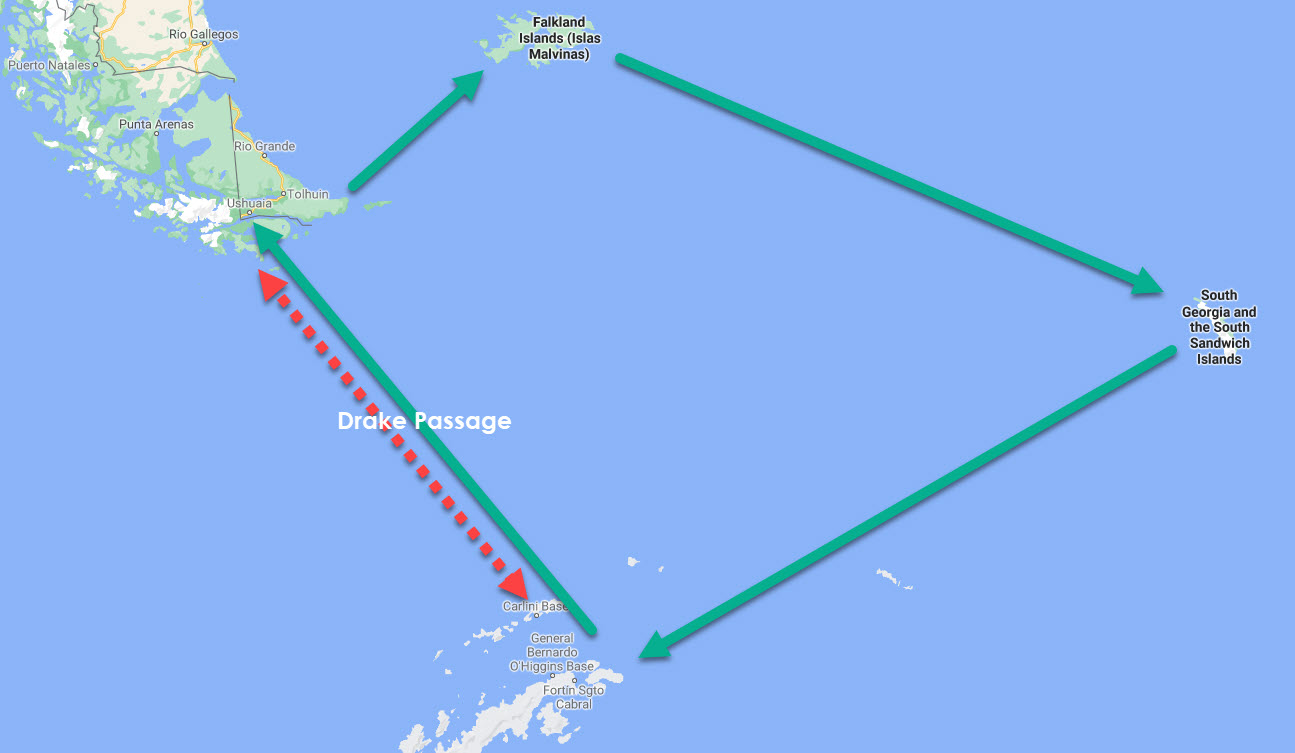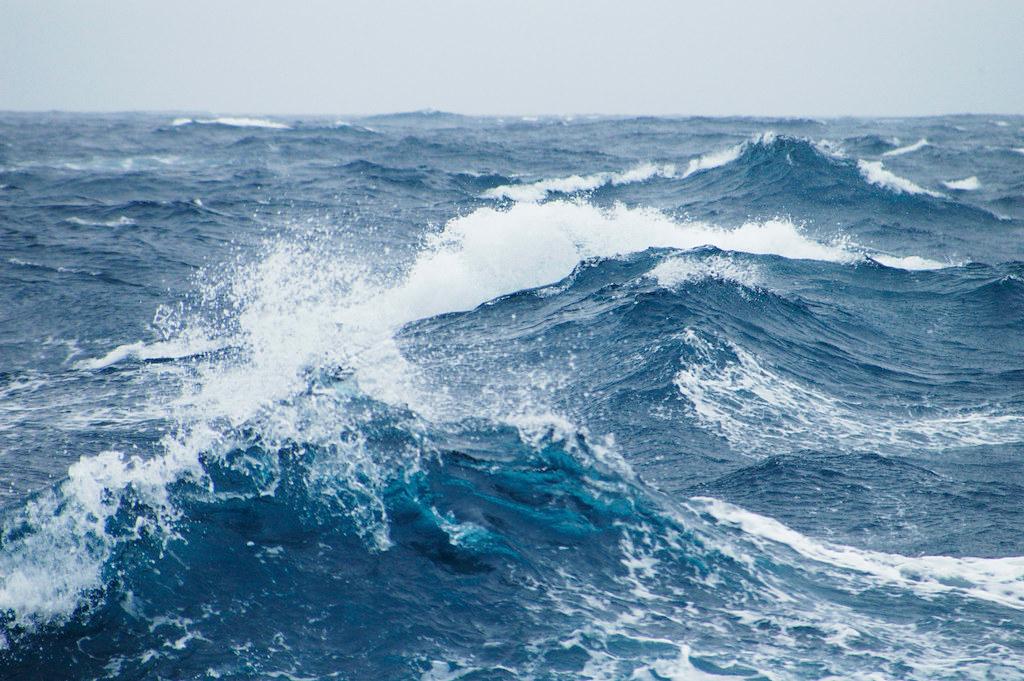If you’re considering an Antarctica adventure trip, you’ve likely already researched (or purposefully skipped over) the Drake Passage. You’ve heard tales of the stormy seas - and yet, you’re still intrigued. Here’s how you can make your White Continent dreams a reality (and even avoid the Drake Shake).
Where Is the Drake Passage?
This renowned 800-kilometer stretch of rough water separates the tip of South America and the South Shetland islands of Antarctica - and is an epic rite of “passage” for all those bound for the White Continent.
Why It’s a Big Deal
There’s no denying it. Crossing the Drake Passage is no walk in the park. It’s a microcosm of the rugged conditions and climate that one can expect upon arrival on the Antarctica Peninsula.
That said, seasickness-prone travelers need not fret - there are several options for getting across and not all include sailing both ways. Rest assured, no matter which way you cross it - fly, cruise, a combination of both - you’ll come home with an authentic and immersive polar experience.
How Should I Cross the Drake Passage?
You’ll encounter two crossings to get to and from the Antarctica Peninsula. Depending on the weather, it is said you will either experience the Drake Shake or the Drake Lake (you can imagine the conditions these monikers imply). If your trip includes the Falkland Islands and/or South Georgia, you need to cross the Drake Passage only once (see the green arrows). If you are only going to the Antarctic Peninsula, you'll have to cross the passage both ways (see the red arrows)

If you choose to cruise the Drake, you’ll spend two days (each way) on the ship. This offers plenty of time for talking to naturalists, birdwatching, glimpsing possible wildlife, and taking part in presentations by glaciologists and penguinologists (did you know there was such a thing?). Your polar education will (hopefully) help take your mind and stomach off the churning waves (Drake Shake) around you and get you even more excited for what’s to come during your Antarctic voyage.
If you choose to fly-cruise, you’ll save valuable time (all the better when trying to fit the typically long Antarctica travel experience into a limited vacation schedule). Fly over the roughest part, sail the other section. (You’ll have the added bonus of a fantastic aerial view of the region.)
Or, fly both ways, optimizing your time in Antarctica. You can fly (for just two hours!) from Punta Arenas to Antarctica, where you’ll board your expedition ship - no stormy crossing required. Once you’re on the Peninsula, you’ll have access to all the same enriching polar activities as those who chose to sail the Drake Passage.
For those adrenaline-seeking passengers, read this first-hand account from Kyle Jordan on his G Adventures journey across the Drake Passage. While the sail across to Antarctica may not be for everyone (in which case, fly!), this honest account may just inspire you - we promise, it’s worth it!
“The sea was angry that day, my friends, like an old man trying to send back soup in a deli. I felt like a wet dirty sock in the washing machine on a 36-hour spin cycle. I’ve never been one to fall ill to motion sickness, but this journey home would be a true test of that. Seventy-five percent of my fellow passengers were locked away in their respective cabins, just feet from the safety of their porcelain barf bag. I’d hug my bed - like a long-lost lover - at night, in hope I wouldn’t end up on the floor. Rather than walk and hold tight to the wall, I’d crawl on all fours to my desired destination. The idea of presenting myself with dignity was a thing of the past; this was about survival. It’s been more than six years since my epic battle with the Drake, one I’ll remember forever.”
I’ve had the privilege of experiencing the awe-inspiring voyage to Antarctica with Hurtigruten, and let me tell you—it was everything I had hoped for and more. It was the classic "Drake Shake" (the sometimes-turbulent crossing from Ushuaia to Antarctica), and I wouldn’t have had it any other way. Sure, the ride was a little rocky, but honestly, if I had been on the calmer "Drake Lake" crossing, I would have felt like I missed out on a key part of the adventure. There's something so thrilling about the waves crashing over the deck, and the stories I came home with were so much richer for it.
While it’s natural to feel a bit uneasy during the journey, I never once felt unsafe or worried about the ship’s ability to handle the conditions. It was all part of the experience—an experience I still talk about to this day.
How did I handle the motion of the ocean? Simple: I found my zen. I spent hours in the observation deck, marveling at the power of nature as we dipped into massive waves. The views were breathtaking as the ship surged through the water, sometimes sending waves cascading over the side like a natural spectacle. And in the evenings, I found myself wishing for Velcro pajamas and snug sheets—because the ship wasn’t just gently rocking; one moment we were swaying north to south, and the next, we’d shift east to west. I just wanted to stay in one place!
But the best part? That wild crossing made the entire adventure feel even more memorable. And I want you to experience the same thrill when you embark on your own polar voyage. After all, the best travel stories are often the ones that challenge you the most.
Which Ship is Best for You?
Affordable yet Authentic
If you're looking to experience Antarctica without breaking the bank, G Adventures and Adventure Canada (via Intrepid) offer excellent value. You’ll get the full Antarctica experience with a more budget-friendly option. This is perfect if price is a key factor but you don’t want to miss out on the adventure.-
Comfort Meets Adventure
For those who want a modern, comfortable ship but still want to immerse themselves in the experience, consider Aurora Expeditions, Hurtigruten Expeditions (HX), Lindblad, or Quark. These companies provide a great balance between luxury and the authentic spirit of exploration. Their ships are designed to ensure you have a comfortable journey while being out in the wildest parts of the world. -
Skip the Drake Passage
If you’d rather avoid the Drake Passage altogether, you can choose Antarctica21, Silversea, Aurora Expeditions, or Quark Expeditions (at varying price points and experiences). These options fly you directly to Antarctica, bypassing the sometimes-intense crossing for those who may not enjoy a bit of rough seas. -
Luxury Cruises
For the full luxury experience, Silversea and Ponant offer an all-inclusive, top-of-the-line experience. From fine dining to personalized service, these ships elevate your polar adventure to a true luxury voyage, with comfort and indulgence every step of the way. -
Active Adventurers
If you’re more of an active traveler and crave exciting opportunities like sea kayaking, Quark Expeditions offers a range of adventurous activities, including the incredible helicopter option to Snow Hill Island in the Weddell Sea to see the elusive Emperor Penguins. This is the choice for travelers seeking something beyond the ordinary.
What's the difference in Ship Size
Why It Matters and How I Can Help You Choose the Right Expedition
Let’s work together to craft an unforgettable adventure to the ends of the earth. Contact me today, and I’ll help you take the next step in planning your polar voyage!
Final Thoughts
Your experience will be one of a lifetime, and I can help you choose the perfect company and ship to make it all happen. The polar regions are waiting—let’s make sure your trip is as extraordinary as the destination itself!
Please sign up for my weekly small ship inspirational newsletter if you haven't already.
